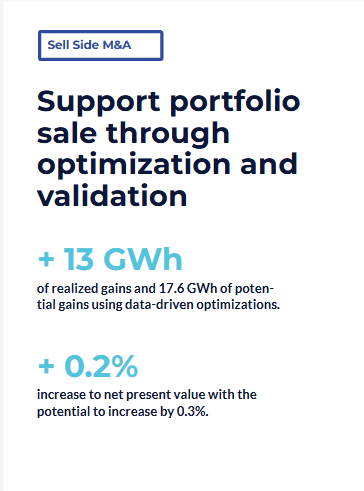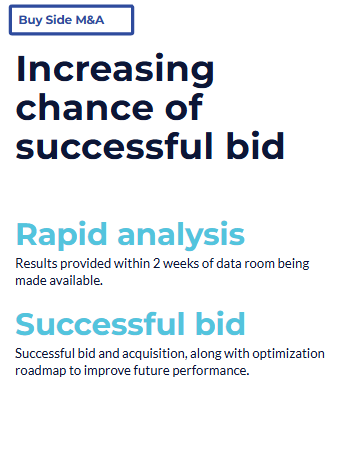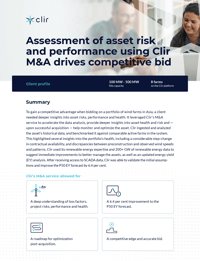
Enabling greater certainty for buyers and sellers
Clir M&A is a software which processes renewable energy site data in days, where it would typically take months. Coupled with the context provided by a 300 GW global industry dataset, Clir enables buyers, sellers and their Technical Advisors with greater certainty on the risk and potential of projects.
Buyer’s journey
1. Indicative bid
A review of the information memorandum, paired with a benchmarking analysis, enables insights into technology, natural catastrophe and BoP risks, as well as overall project quality.
- Binding offer
Rapid analysis of data equips bidders with greater certainty on project potential for an accurate and competitive bid that aligns with risk comfort level.
- Ongoing optimization support
Post-acquisition, clients leverage Clir Portfolio to support the implementation of optimization recommendations surfaced during the data analysis.
Seller’s journey
Onboard historical data
Leverage Clir Portfolio to ingest and analyze historical SCADA data and monthly reports to ensure high-quality data is used in the selling process.
Analysis and validation
Using clean and standardized project data, Clir analyzes the risk and health of the asset, including validating the performance of upgrades.
Coordinate with advisors
Technical analysts or independent engineers review and corroborate on Clir’s findings. Data is then used to update and validate the operational energy yield.
Aid in buyer Journey
Clir’s analysis, data and energy yield are presented to buyers in a comprehensive vendor due diligence package. Clir can also work with advisors
to clarify information for potential buyers.

Support through the M&A process
Non-binding offer
Insight from over 300 GW of market intelligence is used alongside the information memorandum for a more informed bid.
Binding Offer
Ingestion of available site-specific data, along with the market intelligence from industry data, enables increased certainty on asset potential and the optimization roadmap. Data on technical assumptions allows for increased bid confidence.
Post-acquisition
Clir provides support to implement the optimization roadmap for continued operational success.


Problem
When a client was looking to divest their share of a wind portfolio, they wanted to ensure that the effort they had put into improving the assets’ performance would be accurately depicted. The goal was to improve the resulting energy yield assessment and project valuation,
potentially leading to higher bids.
Solution
Using market intelligence and peer data available through Clir, the client had been able to identify several key optimization opportunities, including derating, control anomalies, static and dynamic yaw anomalies, and icing.
The Clir platform also provided insights into how to validate the upgrades and quantify the associated gains. Clir uses industry data to ensure a more accurate assessment of the energy gain and to reduce uncertainty in the final calculations.
With an evidence- based approach, the gains were accepted, reducing uncertainty in the portfolio. This enabled an accurate energy yield assumptions and improvements the P50 and P90, leading to better debt terms and capital.
Problem
When an investment firm wanted to expand ownership of two European wind farms, it needed to understand if there was a business case to buy out the remaining equity from shareholders. With a tight timeline — and trust and confidence in Clir’s data and software — the client contracted Clir to perform an investment-grade operational energy yield for the farms.
Solution
Despite the assets maintaining high levels of availability over the initial two-year operational period, the predicted net P50 of the operational energy yield were more comparable with the 1-year P90 expectation predicted by the pre-construction assessment. The discrepancy was likely due to inaccuracies in the pre-construction measurements and modelling methodology.
The client decided to refrain from immediately purchasing the remaining equity and focus on asset optimization.


Problem
Bid-vs-win ratios are low and bid teams are often encouraged to spend the limited available resource from their fund, compounded with tight timelines leads to bad acquisition decisions.
When Elemental Energy came across an operational asset located in Canada, they wanted to leverage current and historical performance data for superior pre-bid due diligence. This would allow them to bid smarter on the asset for a higher chance of success.
Solution
Clir provided in-depth asset performance insights within two weeks of the data room being made available by the selling party.
Based on Clir’s recommendations and armed with Clir’s assessment, Elemental chose to bid and successfully acquired the project.
With the asset under new ownership, Elemental will continue to use Clir to optimize operational performance. It is expected that the annual energy production (AEP) of the site will increase by 2-3% as a result.

Case study
Clir M&A drives competitive bid and allowed for:

- A deep understanding of loss factors, project risks, performance and health.
- A 6.4 per cent improvement to the P50 EY forecast.
- A roadmap for optimization post-acquisition.
Download Case Study
Frequently asked questions
-
Clir’s wants to quantify what you're bidding on and make that bid as competitive as possible by outlining routes to optimization.
-
Assuming the SCADA data can be analyzed in the timeframe, it is better for the buyer to have than to proceed without it. Data can also be used to confirm/up their valuation.
-
Clir is unaware of any country, other than China, that requires an on-site presence. Clir has also recently passed its SOCII Type II audit.
